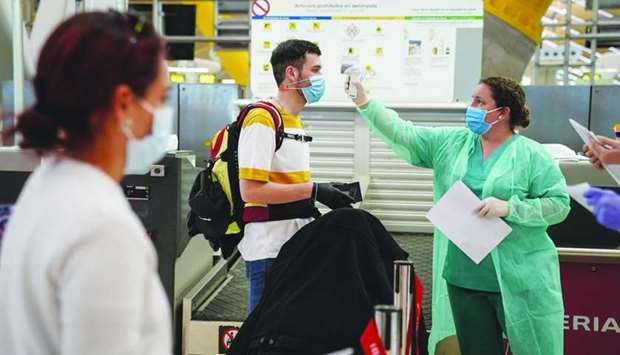Commercial aviation now faces the biggest challenge in its history — restarting an industry that largely has ceased to operate across borders, while ensuring that it is not a meaningful vector for further spread of coronavirus.
Meeting this challenge will certainly mean making significant changes across the arc of the air travel experience — pre-flight, at the departure airport, onboard and post-flight.
Industry leaders — Airports Council International (ACI) World and the International Air Transport Association (IATA) have recently urged governments to ensure any new measures introduced for airports and airlines (in the wake of Covid-19 pandemic) are supported by scientific evidence and are consistent across the world.
Restarting commercial aviation will require governments to assume broad new responsibilities in terms of assessing and identifying traveller health risks, as governments did for security after 9/11 (terrorist attack in the US), points out International Air Transport Association.
Airlines and airports will need to introduce and adapt processes and procedures to minimise contagion risk in the airport and aircraft environments.
Passengers will need to be empowered to take more control of their travel journey, including responsibly assessing their own level of health risk before a journey.
Experts say a layered approach is required for the industry re-start since no single measure will reduce risks and enable a ‘safe flying’ again.
They believe layering measures that are globally implemented and mutually recognised by governments can achieve the needed outcome.
Outlining 'Biosecurity for Air Transport: A Roadmap for Restarting Aviation', the industry captains propose a layering of temporary biosecurity measures.
The roadmap aims to provide the confidence that governments will need to enable the re-opening of borders to passenger travel; and the confidence that travelers will need to return to flying.
Pre-flight, the global trade body of airlines foresees the need for governments to collect passenger data in advance of travel, including health information, which should be accomplished using well-tested channels such as those used for eVisa or electronic travel authorisation programs.
At the departure airport, several layers of protective measures have been proposed.
Access to the terminal building, it has been proposed to be restricted to airport/airline workers and travellers (with exceptions being made for those accompanying passengers with disabilities or unaccompanied minors), temperature screening by trained government staff at entry points to the terminal building, physical distancing through all passenger processes, including queue management, use of face coverings for passengers and masks for staff in line with local regulations.
Self-service options for check-in used by passengers as much as possible to reduce contact points and queues. This includes remote check-in (electronic/home printed boarding passes), automated bag drops (with home printed bag tags) and self-boarding.
Boarding should be made as efficient as possible with re-designed gate areas, congestion-reducing boarding priorities, and hand luggage limitations.
Cleaning and sanitisation of high touch areas must be in line with local regulations. This includes wide availability of hand sanitisers, it is suggested.
In-flight, the roadmap foresees several layers of protective measures: face coverings required for all passengers and non-surgical masks for crew, simplified cabin service and pre-packaged catering to reduce interaction between passengers and crew, reduced congregation of passengers in the cabin, for example by prohibiting queues for washrooms and enhanced and more frequent deep cleaning of the cabin.
At the arrival airport too, several layers of protective measures have been proposed.
These include temperature screening by trained government staff if required by authorities, automated procedures for customs and border control, including use of mobile applications and biometric technologies (which have already proven track record by some governments), accelerated processing and baggage reclaim to enable social distancing by reducing congestion and queuing.
Health declarations and robust contact tracing are expected to be undertaken by governments to reduce the risk of imported chains of transmission.
Meanwhile, reports say airlines added more seats back to their flight schedules this week, led by carriers in China and Hong Kong, suggesting the industry is starting to recover from the devastating impact of the coronavirus pandemic, according to OAG Aviation Worldwide.
Carriers globally added a net 600,000 seats to reach a total of almost 30mn, up about 2% from the previous week, OAG senior analyst John Grant wrote in a report, according to Bloomberg.
That’s still a long way off the weekly capacity of about 110mn seats this time last year, but it is an encouraging sign nonetheless.
“There is no single measure that will reduce risk and enable a safe re-start of flying. But a layering of measures that are globally implemented and mutually recognised by governments can achieve the needed outcome.
“This is the greatest crisis that aviation has ever faced. A layered approach has worked with safety and with security. It’s the way forward for biosecurity as well,” said Alexandre de Juniac, IATA’s director general and CEO.
Undoubtedly, collaboration among governments and between governments and industry, which is vital to ensure the harmonisation and consistency of measures, are essential to restoring air connectivity and passenger confidence in air travel.
Industry leaders — Airports Council International (ACI) World and the International Air Transport Association (IATA) have recently urged governments to ensure any new measures introduced for airports and airlines (in the wake of Covid-19 pandemic) are supported by scientific evidence and are consistent across the world.
Restarting commercial aviation will require governments to assume broad new responsibilities in terms of assessing and identifying traveller health risks, as governments did for security after 9/11 (terrorist attack in the US), points out International Air Transport Association.
Airlines and airports will need to introduce and adapt processes and procedures to minimise contagion risk in the airport and aircraft environments.
Passengers will need to be empowered to take more control of their travel journey, including responsibly assessing their own level of health risk before a journey.
Experts say a layered approach is required for the industry re-start since no single measure will reduce risks and enable a ‘safe flying’ again.
They believe layering measures that are globally implemented and mutually recognised by governments can achieve the needed outcome.
Outlining 'Biosecurity for Air Transport: A Roadmap for Restarting Aviation', the industry captains propose a layering of temporary biosecurity measures.
The roadmap aims to provide the confidence that governments will need to enable the re-opening of borders to passenger travel; and the confidence that travelers will need to return to flying.
Pre-flight, the global trade body of airlines foresees the need for governments to collect passenger data in advance of travel, including health information, which should be accomplished using well-tested channels such as those used for eVisa or electronic travel authorisation programs.
At the departure airport, several layers of protective measures have been proposed.
Access to the terminal building, it has been proposed to be restricted to airport/airline workers and travellers (with exceptions being made for those accompanying passengers with disabilities or unaccompanied minors), temperature screening by trained government staff at entry points to the terminal building, physical distancing through all passenger processes, including queue management, use of face coverings for passengers and masks for staff in line with local regulations.
Self-service options for check-in used by passengers as much as possible to reduce contact points and queues. This includes remote check-in (electronic/home printed boarding passes), automated bag drops (with home printed bag tags) and self-boarding.
Boarding should be made as efficient as possible with re-designed gate areas, congestion-reducing boarding priorities, and hand luggage limitations.
Cleaning and sanitisation of high touch areas must be in line with local regulations. This includes wide availability of hand sanitisers, it is suggested.
In-flight, the roadmap foresees several layers of protective measures: face coverings required for all passengers and non-surgical masks for crew, simplified cabin service and pre-packaged catering to reduce interaction between passengers and crew, reduced congregation of passengers in the cabin, for example by prohibiting queues for washrooms and enhanced and more frequent deep cleaning of the cabin.
At the arrival airport too, several layers of protective measures have been proposed.
These include temperature screening by trained government staff if required by authorities, automated procedures for customs and border control, including use of mobile applications and biometric technologies (which have already proven track record by some governments), accelerated processing and baggage reclaim to enable social distancing by reducing congestion and queuing.
Health declarations and robust contact tracing are expected to be undertaken by governments to reduce the risk of imported chains of transmission.
Meanwhile, reports say airlines added more seats back to their flight schedules this week, led by carriers in China and Hong Kong, suggesting the industry is starting to recover from the devastating impact of the coronavirus pandemic, according to OAG Aviation Worldwide.
Carriers globally added a net 600,000 seats to reach a total of almost 30mn, up about 2% from the previous week, OAG senior analyst John Grant wrote in a report, according to Bloomberg.
That’s still a long way off the weekly capacity of about 110mn seats this time last year, but it is an encouraging sign nonetheless.
“There is no single measure that will reduce risk and enable a safe re-start of flying. But a layering of measures that are globally implemented and mutually recognised by governments can achieve the needed outcome.
“This is the greatest crisis that aviation has ever faced. A layered approach has worked with safety and with security. It’s the way forward for biosecurity as well,” said Alexandre de Juniac, IATA’s director general and CEO.
Undoubtedly, collaboration among governments and between governments and industry, which is vital to ensure the harmonisation and consistency of measures, are essential to restoring air connectivity and passenger confidence in air travel.




